Related Research Articles

Primates are a diverse order of mammals. They are divided into the strepsirrhines, which include the lemurs, galagos, and lorisids, and the haplorhines, which include the tarsiers and the simians. Primates arose 85–55 million years ago first from small terrestrial mammals, which adapted to living in the trees of tropical forests: many primate characteristics represent adaptations to life in this challenging environment, including large brains, visual acuity, color vision, a shoulder girdle allowing a large degree of movement in the shoulder joint, and dexterous hands. Primates range in size from Madame Berthe's mouse lemur, which weighs 30 g (1 oz), to the eastern gorilla, weighing over 200 kg (440 lb). There are 376–524 species of living primates, depending on which classification is used. New primate species continue to be discovered: over 25 species were described in the 2000s, 36 in the 2010s, and three in the 2020s.

Black-and-white colobuses are Old World monkeys of the genus Colobus, native to Africa. They are closely related to the red colobus monkeys of genus Piliocolobus. There are five species of this monkey, and at least eight subspecies. They are generally found in high-density forests where they forage on leaves, flowers and fruit. Social groups of colobus are diverse, varying from group to group. Resident-egalitarian and allomothering relationships have been observed among the female population. Complex behaviours have also been observed in this species, including greeting rituals and varying group sleeping patterns. Colobi play a significant role in seed dispersal.

The Zanzibar red colobus is a species of red colobus monkey endemic to Unguja, the main island of the Zanzibar Archipelago, off the coast of Tanzania. It is also known as Kirk's red colobus after Sir John Kirk, the British Resident of Zanzibar who first brought it to the attention of zoological science. It is now classified as an endangered species and in the mid-1990s was adopted as the flagship species for conservation in Zanzibar. The population is still decreasing, and conservationists are attempting to work with the local government to devise a proper, effective strategy to protect the population and habitat. Challenges include the species' habitat, which is limited to the archipelago. The species has been reclassified three times; it was previously in the genus Colobus, then in the genus Procolobus, and later in the genus Piliocolobus.

Kibale National Park is a national park in western Uganda, protecting moist evergreen rainforest. It is 766 square kilometres (296 sq mi) in size and ranges between 1,100 metres (3,600 ft) and 1,600 metres (5,200 ft) in elevation. Despite encompassing primarily moist evergreen forest, it contains a diverse array of landscapes. Kibale is one of the last remaining expanses to contain both lowland and montane forests. In eastern Africa, it sustains the last significant expanse of pre-montane forest.

The mantled guereza, also known simply as the guereza, the eastern black-and-white colobus, or the Abyssinian black-and-white colobus, is a black-and-white colobus, a type of Old World monkey. It is native to much of west central and east Africa, including Cameroon, Equatorial Guinea, Nigeria, Ethiopia, Kenya, Tanzania, Uganda and Chad. The species consists of several subspecies that differ in appearance. It has a distinctive appearance, which is alluded to in its name; the long white fringes of hair that run along each side of its black trunk are known as a mantle. Its face is framed with white hair and it has a large white tail tuft.

Richard Walter Wrangham is an English anthropologist and primatologist; he is Professor of Biological Anthropology at Harvard University. His research and writing have involved ape behavior, human evolution, violence, and cooking.
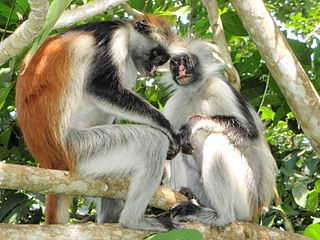
Red colobuses are Old World monkeys of the genus Piliocolobus. It was formerly considered a subgenus within the genus Procolobus, which is now restricted to the olive colobus. They are closely related to the black-and-white colobus monkeys, and some species are often found in groups with the blue monkey. The western red colobus is frequently hunted by the common chimpanzee.

Miss Waldron's red colobus is a species of the red colobus native to West Africa. It had previously been described as a subspecies of the western red colobus, P. badius. It has not been officially sighted since 1978 and was considered extinct in 2000. However, new evidence suggests that a very small number of these monkeys may be living in the southeast corner of Côte d'Ivoire. The IUCN Red List notes Miss Waldron's red colobus as critically endangered.
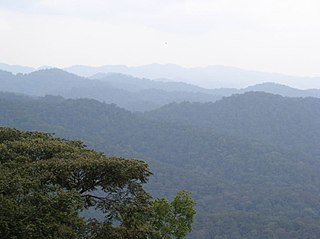
The Albertine Rift montane forests is a tropical moist broadleaf forest ecoregion in east-central Africa. The ecoregion covers the mountains of the northern Albertine Rift, and is home to distinct Afromontane forests with high biodiversity.

The black colobus, or satanic black colobus, is a species of Old World monkey belonging to the genus Colobus. The species is found in a small area of western central Africa. Black colobuses are large, completely covered with black fur, and like all other Colobus monkeys, do not have a thumb. The species has faced large declines in population due to habitat destruction and hunting by humans, and was consequently listed as Vulnerable on the IUCN Red List in 1994.

The wildlife of Uganda is composed of its flora and fauna. Uganda has a wide variety of different habitats, including mountains, hills, tropical rainforest, woodland, freshwater lakes, swamps and savanna with scattered clumps of trees. The country has a biodiverse flora and fauna reflecting this range of habitats and is known for its primates, including gorillas and chimpanzees. There are ten national parks and thirteen wildlife reserves; some 345 species of mammal and 1020 species of bird have been recorded in the country.
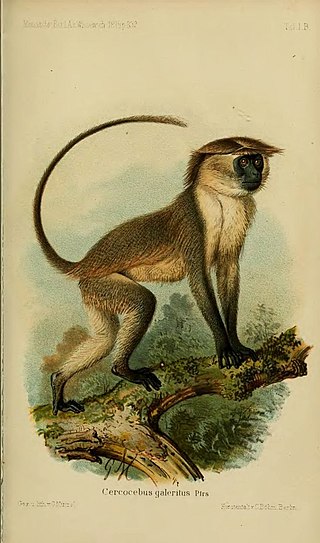
The Tana River mangabey is a highly endangered species of primate in the family Cercopithecidae. Some authorities have included the taxa agilis and sanjei as subspecies of this species, while others award these full species status.

The moustached guenon or moustached monkey is a species of primate in the family Cercopithecidae. It is found in Angola, Cameroon, Central African Republic, Republic of the Congo, Democratic Republic of the Congo, Equatorial Guinea, and Gabon.
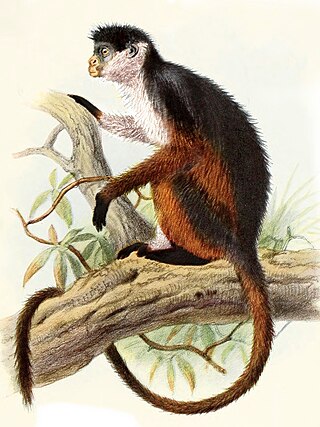
Pennant's colobus or Pennant's red colobus is a species of tree-dwelling primate in the family Cercopithecidae. It is endemic to tropical Central Africa. Three subspecies have traditionally been recognised but its distribution is peculiarly disjunct and has been considered a biogeographical puzzle, with one population on the island of Bioko, a second in the Niger River Delta in southern Nigeria, and a third in east-central Republic of Congo. It is found in rainforests and marshy forests. It is threatened by habitat loss and hunting for bushmeat.
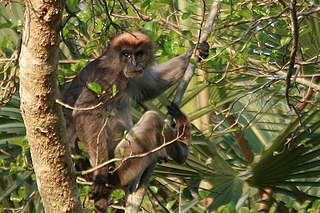
The Tana River red colobus, also called the eastern red colobus, is a highly endangered species of primate in the family Cercopithecidae. It is endemic to a narrow zone of gallery forest near the Tana River in southeastern Kenya.

The olive colobus monkey, also known as the green colobus or Van Beneden's colobus, is a species of primate in the family Cercopithecidae. Its English name refers to its dull olive upperparts. It is the smallest example of all colobine monkeys and is rarely observed in its natural habitat because of its cryptic coloration and secretive nature. It is found in the rain forests of West Africa, ranging from southern Sierra Leone to Nigeria. The IUCN Red List classifies the olive colobus as vulnerable, with the cause of its decline attributed to habitat loss and hunting. Though much of the land within the range of the olive colobus has been affected by human activities, it retains its ability to thrive in small degraded forest fragments.
Afromorus mesozygia, known as black mulberry or African mulberry, is the only species in the genus Afromorus. The plant is a small- to medium-sized forest tree of Tropical Africa. Its leaves and fruit provide food for the mantled guereza, a colobus monkey native to much of Tropical Africa, and for the common chimpanzee of West and Central Africa. It is also a commercial hardwood.

The Ugandan red colobus or ashy red colobus is an endangered species of red colobus monkey, recognised as a distinct species since 2001. There is disagreement however over taxonomy with many considering the Ugandan red colobus to be a subspecies. The Ugandan red colobus is an Old World monkey which is found in five different locations across Uganda and Tanzania.
Lynne A. Isbell is an American ethologist and primatologist, professor of anthropology at the University of California, Davis.
John Massa Kasenene is a botanical and environmental ecologist, academic, scientist and academic administrator in Uganda. From 4 October 2022, he serves as the substantive Deputy Vice Chancellor of the Mountains of the Moon University (MMU), at that time, the tenth public university in the country.
References
- ↑ "Grants Program". National Geographic Society .
- ↑ Box, Hilary; Butynski, Thomas M.; Chapman, Colin A.; Lwanga, Jeremiah S.; Oates, John F.; Olupot, William; Rudran, Rudy; Waser, Peter M. (2008-01-29). "Thomas T. Struhsaker: Recipient of the Lifetime Achievement Award of the International Primatological Society 2006". International Journal of Primatology. 29 (1): 13–18. doi:10.1007/s10764-007-9155-3. ISSN 0164-0291. S2CID 31433764.
- ↑ "Makerere University Biological Field Station - Kibale - Home". caes.mak.ac.ug. Archived from the original on 2016-11-13. Retrieved 2016-11-10.
- ↑ Johns A.D., Chapman L.J., Chapman C.A. 1991 A field station profile: Makerere University Biological Field Station. Tropinet (Fall).
- ↑ Chapman, Colin A.; Struhsaker, Thomas T.; Lambert, Joanna E. (2005). "Thirty Years of Research in Kibale National Park, Uganda, Reveals a Complex Picture for Conservation". International Journal of Primatology. 26 (3): 539–555. CiteSeerX 10.1.1.671.8258 . doi:10.1007/s10764-005-4365-z. ISSN 0164-0291. S2CID 5577722.
- ↑ Kasenene J., Ross E. 2008 Community benefits from long-term research programs: a case study from Kibale National Park, Uganda. (pp. 99-114, Cambridge University Press, Cambridge, UK.
- 1 2 Chapman, Colin A.; Bavel, Bianca van; Boodman, Carl; Ghai, Ria R.; Gogarten, Jan F.; Hartter, Joel; Mechak, Lauren E.; Omeja, Patrick A.; Poonawala, Sofia (2015-10-01). "Providing health care to improve community perceptions of protected areas". Oryx. 49 (4): 636–642. doi:10.1017/S0030605313001592. ISSN 0030-6053. PMC 4594866 . PMID 26456977.
- 1 2 Chapman C.A., Chapman L.J. 2000 Determinants of group size in primates: the importance of travel costs. In On the move: how and why animals travel in groups (eds. Boinski S., Garber P.A.), pp. 24-41. Chicago, University of Chicago Press.
- ↑ Omeja, Patrick A.; Jacob, Aerin L.; Lawes, Michael J.; Lwanga, Jeremiah S.; Rothman, Jessica M.; Tumwesigye, Charles; Chapman, Colin A. (2014-11-01). "Changes in Elephant Abundance Affect Forest Composition or Regeneration?". Biotropica. 46 (6): 704–711. doi:10.1111/btp.12154. ISSN 1744-7429. S2CID 38677653.
- ↑ Chapman, Colin A.; Chapman, Lauren J. (1997-12-01). "Forest Regeneration in Logged and Unlogged Forests of Kibale National Park, Uganda". Biotropica. 29 (4): 396–412. doi:10.1111/j.1744-7429.1997.tb00035.x. ISSN 1744-7429. S2CID 84685726.
- ↑ Alexander, R D (1974-11-01). "The Evolution of Social Behavior". Annual Review of Ecology and Systematics. 5 (1): 325–383. doi:10.1146/annurev.es.05.110174.001545. ISSN 0066-4162.
- ↑ Ganas, Jessica; Robbins, Martha M. (2005-03-09). "Ranging behavior of the mountain gorillas (Gorilla beringei beringei) in Bwindi Impenetrable National Park, Uganda: a test of the ecological constraints model". Behavioral Ecology and Sociobiology. 58 (3): 277–288. doi:10.1007/s00265-005-0920-z. ISSN 0340-5443. S2CID 29533701.
- ↑ Wrangham, R. W.; Gittleman, J. L.; Chapman, C. A. (1993). "Constraints on group size in primates and carnivores: population density and day-range as assays of exploitation competition". Behavioral Ecology and Sociobiology. 32 (3): 199–209. doi:10.1007/BF00173778. ISSN 0340-5443. S2CID 24665859.
- 1 2 Chapman, C. A.; Chapman, L. J.; Wrangham, R. W. (1995). "Ecological constraints on group size: an analysis of spider monkey and chimpanzee subgroups". Behavioral Ecology and Sociobiology. 36 (1): 59–70. doi:10.1007/BF00175729. ISSN 0340-5443. S2CID 22958072.
- 1 2 Chapman, Colin A.; Chapman, Lauren J. (2000). "Constraints on Group Size in Red Colobus and Red-tailed Guenons: Examining the Generality of the Ecological Constraints Model". International Journal of Primatology. 21 (4): 565–585. doi:10.1023/A:1005557002854. ISSN 0164-0291. S2CID 1472332.
- ↑ Hansen, M. C.; Potapov, P. V.; Moore, R.; Hancher, M.; Turubanova, S. A.; Tyukavina, A.; Thau, D.; Stehman, S. V.; Goetz, S. J. (2013-11-15). "High-Resolution Global Maps of 21st-Century Forest Cover Change". Science. 342 (6160): 850–853. Bibcode:2013Sci...342..850H. doi:10.1126/science.1244693. ISSN 0036-8075. PMID 24233722. S2CID 23541992.
- ↑ Estrada, Alejandro (2013-01-01). "Socioeconomic Contexts of Primate Conservation: Population, Poverty, Global Economic Demands, and Sustainable Land Use". American Journal of Primatology. 75 (1): 30–45. doi:10.1002/ajp.22080. ISSN 1098-2345. PMID 23047543. S2CID 33524396.